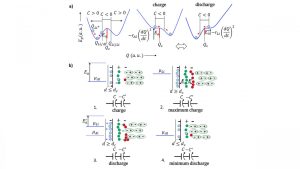
A team of engineers from the University of Porto in Portugal and the University of Texas at Austin has designed a simple battery capable of self-charging. The battery is composed of two distinct metals, and a single sodium or lithium glass electrolyte which is placed between the two.
By combining negative resistance and negative capacitance into one cell, engineers were able to craft a device that can self-charge without expending energy. This technology could have countless applications for low-frequency communications, as well as everything from electronic beepers and digital converters to blinking lights and inverters.
While the battery is deceptively simple, there was one piece of it that was essential to its success: the lithium-rich glass electrolyte. This allows the electrolyte to simultaneously provide both electrodes with lithium ions, removing the need for a lithium metal to be involved in the design.
Besides helping to develop a new type of energy source, the research also manages to unify the theory behind all solid-state devices. This theory states that assorted different materials that are in electrical contact will exhibit the properties of the materials once they have been combined, as opposed to keeping their individual properties.
The open circuit potential difference between the electrodes found in a battery occurs as a result of an electrical imperative to align the Fermi levels. The Fermi levels are a way of measuring the energy of the electrons least tightly hold within a solid material. The Fermi levels also inform the specific levels of the electrode’s polarity. Later on in the process, chemical reactions will begin. These are fed directly from the electrical potential energy, which is stored in the capacitors.
Additionally, the self-cycling process can be mitigated or stopped entirely to preserve energy and improve sustainability. To achieve this, engineers merely have to prevent the change in Fermi levels, or they can configure a negative resistance which will prevent self-cycling until it is once again ready to resume.
The team behind this battery hope their research could one day lead to a device that has the ability to self-charge without going through the self-cycling process. For now, they are continuing to delve into the research surrounding their new battery design.
